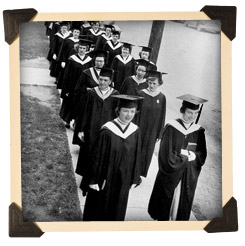 The Records Management and Archives Department is engaged in several archival projects to capture and promote the history of Marywood University and to preserve, arrange, and enhance the accessibilty of some of Marywood's most frequently used archives and those archival materials in greatest need of care.
The Records Management and Archives Department is engaged in several archival projects to capture and promote the history of Marywood University and to preserve, arrange, and enhance the accessibilty of some of Marywood's most frequently used archives and those archival materials in greatest need of care.
The Chronology of the University
This chronological chart, containing text and images, documents the history of Marywood (College) University from before its founding in 1915 to the present.
The Archives Catalog
Prior to 2002, the finding aids of the University Archives comprised hundreds of individual word processor files that vaguely identified the contents of selected parts of the collection. This, coupled with a lack of finding aids for much of the collection, made archival research an ineffective and inefficient process.
The Department has developed a single Archives Catalog database for all archival records. To date, nearly every archival acquisition since August 2002 has been cataloged, and we are expanding the finding aids of the past and cataloging archives for which no finding aids exist. The Catalog contains informative series introductions and a standard hierarchy of metadata for each acquisition, making these archives accessible for research. This process has required some physical reorganization of archival records, further enhancing their accessibility.
In time, the Archives Catalog will be searchable online through the Records Management and Archives Website.
Binding of University Publications
In the past, selected University publications were professionally bound to preserve them for future use. However, in recent decades, this project has lapsed.
In 2006, once the cataloging of two publications, Marywood (College) University Catalogs (1915-Present) and the Bay Leaf (1919-Present), was complete, the professional binding of at least one copy of each issue was brought up to date.
In 2007 the following alumni publications were cataloged and bound: The Alumnae Leaf, The Alumnae Leaflet, Your College and You, Marywood College Alumnae Chapter Newsletter, AlumNews, and The Marywood Milieu.
In 2008, all issues of Impressions were cataloged and bound.
The next publication slated for binding is the Wood Word.
Preservation of Archival News Clippings
Since the founding of Marywood College in 1915, members of the Marywood Community have chronicled the history of the institution in scrapbooks. By 2002, over 230 large scrapbooks had been created or received by the University Archives. However, time and chemical processes have taken a toll on the scrapbooks and their contents. The scrapbook paper contains lignin, a natural polymer that is unstable and light-sensitive. As it ages, lignin breaks down into acid compounds, contributing to the degradation of paper materials by causing them to become discolored and brittle. Since the most common items in the scrapbooks are delicate news clippings, they are deteriorating quickly and require immediate care to prevent their complete disintegration.
The Records Management and Archives Department is removing the contents of the scrapbooks to preserve them according to archival best practice. We are reformatting news clippings by photocopying them onto acid-free paper and printing the publication information onto each page as a heading. The reformatted news clippings are then cataloged and chronologically arranged in archival-safe polypropylene boxes. We also are cataloging other archival materials from the scrapbooks (letters, programs, souvenirs, etc.) and housing them in archival-safe containers.
Identification, Arrangement, and Preservation of Photographic Archives
Marywood University owns approximately 30,000 photographic archives, including photographs, slides, contact sheets, and 35mm and glass plate negatives, some of which date to the late nineteenth century. Over the years, some of these photographs were damaged or stacked in file folders, where they began to stick together. A large segment of the collection was also housed in chemically unstable files containing acid substances, which can weaken the cellulose in paper materials, causing discoloration. Many other photographs are still stored in folders throughout the archives.
No organized system had been implemented for classifying the photographic collection or identifying its images, making searches for specific photographs very time-intensive. As a result of such searches, excessive handling has further damaged these delicate materials.
Since 2002, over 5,000 of the most at-risk photographs have been removed from their unstable containers, identified, and labeled by event, location, date, and people and objects in the images. We are arranging these photographs chronologically; storing them individually in acid-free, transparent polypropylene sleeves, along with identifying information printed onto acid-free paper; and housing them in archival-safe polypropylene boxes. The identifying information is electronically searchable, facilitating research and minimizing the handling of photographic archives.
Other sections of the collection also will undergo this process, preserving Marywood's archival photographs for the enjoyment and edification of future generations.
In 2007, Marywood's 144 glass plate negatives were housed, according to archival standards, in loosely-fitting, buffered paper sleeves that protect the negatives' emulsions.
 The Index to Marywood College: The First Seventy-five Years: A Retrospective
The Index to Marywood College: The First Seventy-five Years: A Retrospective
One of the best starting points for research on the history of Marywood University is a book by a former Marywood College English professor, Margaret Yarina, Ph.D., entitled Marywood College: The First Seventy-five Years: A Retrospective (1990). With the assistance of a volunteer, the Director of Records Management and Archives has indexed this book to facilitate archival research and promote the history of Marywood University. The 55-page index is available in the Records Management and Archives Department.
